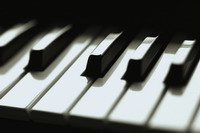Piano Sheets > Melvin Endsley Sheet Music > Singing The Blues (ver. 1) Piano Sheet
Singing The Blues (ver. 1) by Melvin Endsley - Piano Sheets and Free Sheet Music

About the Song
"Singing the Blues" is a popular song. It was written by Melvin Endsley and was published in 1956.
The best-known recording of the song, released in October 1956 by Guy Mitchell, spent 9 weeks at #1 on the Billboard chart from December 8, 1956 - February 2, 1957, despite competition from rival versions by Tommy Steele and Marty Robbins. Tommy Steele's version also made no. 1 in the UK Singles Chart for one week on 11 January 1957, sandwiched by the two weeks that Guy Mitchell spent at #1 in the UK.
The song became a UK Top 30 hit for Dave Edmunds in 1980. Other notable cover versions include a 1960 recording by Bill Haley & His Comets, a 1963 version by Dean Martin, and a 1971 version by Black Oak Arkansas. In the United Kingdom both the versions by Steele and Mitchell hit #1 in the same year. The song was a hit again in 1994 when covered by Daniel O'Donnell. It is not related to the song "Singin' the Blues," written by Sam Lewis, Joe Young, Con Conrad and J. Russel Robinson and recorded by Frank Trumbauer and Bix Beiderbecke in 1927. The tune was also sung by Vivian Vance and William Frawley (Ethel and Fred of I Love Lucy fame) for a Ford Motor Company television commercial promoting the Edsel.
A cover version was released by Marie Osmond on her 1975 album In My Little Corner of the World. (MGM SE4944)
"Singing the Blues" was performed live by Paul McCartney on the MTV show Unplugged in 1991 and included on the subsequent soundtrack, Unplugged (The Official Bootleg).
A cover version was released by the Kentucky Headhunters on their 1997 album Stompin' Grounds.
A "Singing The Blues" cover version was released by Gene Summers on his 1981 French album Gene Summers In Nashville (Big Beat Records BBR-0011)
The first line of this song is famously the last line of London Calling by the Clash, cut short and echoed in the final mix of the song (I never felt so much a-like, a-like, a-like...).
This song has also famously been used by Sheffield Wednesday fans since the 'Boxing Day Massacre', on December 26, 1979, where the Owls beat their fierce rivals, Sheffield United, 4-0. One of the Wednesday scorers on that day,Terry Curran, even recorded a version of the song and is still used at Hillsborough to this day.
Download this sheet!
About the Artist

Random article
Sheet music, theory and beyond When you take a look at a piano music sheet for the first time, all you will see is beautiful written characters which make absolutely no sense to you. And if you are a keen observer, you will notice that there are many types of circles associated with the piano music sheet language. Sheet music belonging to the instrument piano also consists of incomplete circles connected together by one or a collection of lines. Plus there are other symbols which will appear totally strange to you. So what are they all about and what do they mean? (More...)
